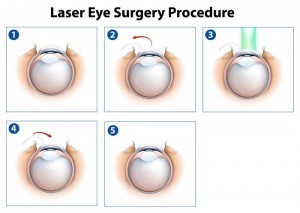Astigmatism
Astigmatism is a refractive error of the eye in which the eye is not able to focus light properly. Instead of light focusing on a single point on the retina, there are multiple, focal points in front of the retina, behind it, or sometimes both. This causes the image to look blurred or distorted regardless of the distance.
What Causes an Astigmatism?
The cornea and lens of the eye are responsible for focusing and refracting light to create a clear image. Ideally, the surface of your eye has a smooth, even curvature.
This allows all of the incoming light to be refracted in the same way onto the retina to create a clear image. In cases of astigmatism, either the cornea or the lens is unevenly curved. The shape is more like that of a football than a symmetrical round ball.
If the eye were divided by an imaginary line horizontally and vertically, one meridian would be significantly more curved than the other. This causes the incoming light to be unevenly focused. Astigmatism often occurs in combination with other refractive eye conditions, including nearsightedness and farsightedness.
In many cases, astigmatism is present from birth or develops early in life. This makes it extremely important for young children to have regular eye exams so vision problems can be corrected before they cause problems with school.
What are the Symptoms of Astigmatism?
The most common symptom of astigmatism is blurred vision. Depending on the exact shape of the lens or cornea, the blurring may be more pronounced vertically, horizontally, or diagonally. Other typical symptoms include eyestrain, frequent headaches, and squinting.
Types of Astigmatism:
• Myopic astigmatism (meridians are nearsighted)
• Hyperopic astigmatism (one or both meridians are farsighted)
• Mixed astigmatism (one meridian is farsighted, and the other is nearsighted)
Astigmatism is also classified as irregular or regular. In cases of regular astigmatism, the principal meridians of the eye are perpendicular to each other at a 90-degree angle.
With irregular astigmatism, the meridians are not perfectly perpendicular. Irregular astigmatism can occur as the result of scarring from eye surgery or injury. It also can also be caused by a condition called keratoconus, which causes the lens to gradually thin and become more cone-shaped. Lasik of Nevada’s Dr. Rouweyha is a seasoned professional in the diagnosis and treatment of Keratoconus.
How is Astigmatism Diagnosed?
Astigmatism is diagnosed through a routine eye exam in the same way as farsightedness and nearsightedness. Most eye doctors use either a manual technique called a retinoscopy or an automated one. During a manual retinoscopy, the doctor uses an instrument called a phoropter, which is equipped with various lenses. The doctor has you read an eye chart as he or she changes the lenses one at a time while you compare the images.
Treatment Options
The most common treatment option for astigmatism is corrective lenses. These may be either glasses or toric or gas permeable contact lenses. Individuals seeking long-term vision correction without glasses or contacts often turn to refractive surgery, also known as LASIK. The acronym LASIK stands for laser-assisted
The acronym LASIK stands for laser-assisted in situ keratomileuses. This procedure reshapes the cornea by removing tiny amounts of eye tissue.
In most cases, LASIK allows patients to enjoy near 20/20 vision without glasses or contacts. If you do still need corrective lenses after LASIK, the prescription is typically much lower than before the surgery. The procedure takes approximately 10 minutes per eye. Most people can resume normal activities within a couple of days! Find out if you’re a good candidate for LASIK by taking a free Self Candidate Quiz.
Test Your Eyes for Astigmatism
You can take this basic eye test to see if you may be experiencing vision problems. The test measures visual acuity, astigmatism, and color blindness.



